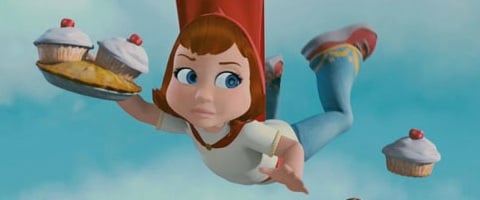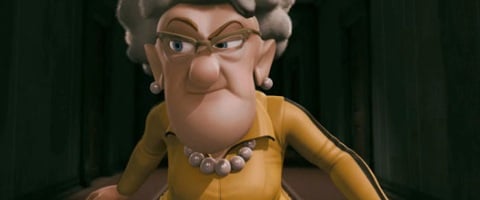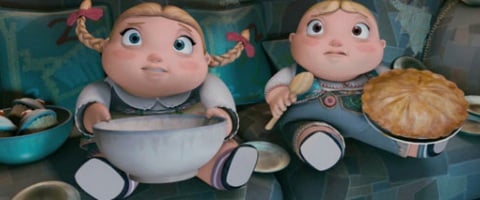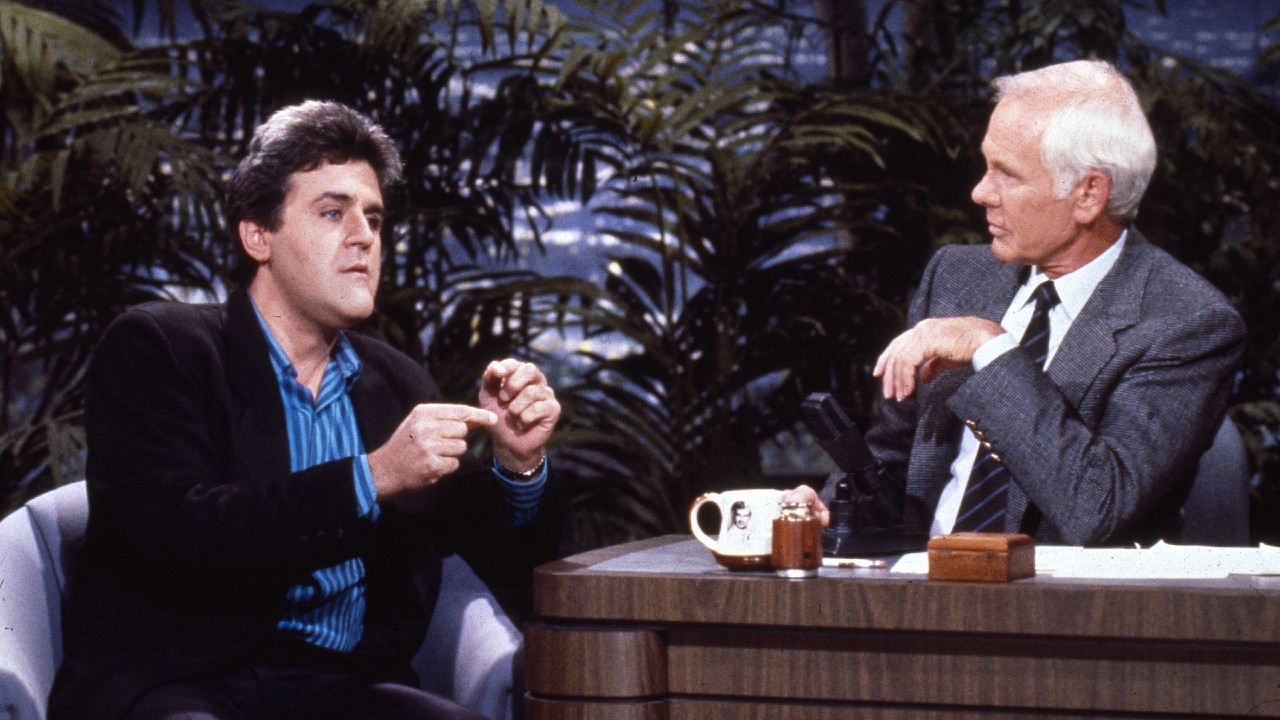To 3D Or Not To 3D: Buy The Right Hoodwinked Too Ticket

Not only is Hoodwinked Too: Hood vs. Evil the sequel to a 2005 movie, Hoodwinked, that you most definitely weren't asking for. Not only is it a movie that was so close to being released in 2010 that Burger King put toys into production that January. Not only does it boast the distinction of replacing Oscar-nominee Anne Hathaway, who voiced Red Riding Hood in the original, with "the cheerleader" Hayden Panettiere. But Hoodwinked Too is that rare bird of a post-converted 3D animated film, at a time when all the major animation studios plan their films for 3D and most moviegoers have become aware that "post-conversion 3D" is code for "3D that's either useless or not that good."
So does the "Hood" stand a chance against the Evil that is post-conversion 3D? And more importantly, is it worth shelling out the extra few bucks to slap on the glasses and glimpse the extra dimension? Check out our latest installment of To 3D or Not To 3D below to find out.

Does It Fit?
Animated films-- even cheap, poorly executed animated films like Hoodwinked Too: Hood Vs. Evil-- are always the best fit for 3D technology. The bright visuals and complete control of an animated universe means that even if the filmmakers aren't doing anything interesting with the 3D, they're never going to have the problems of camera movements or distorted planes that you get in live-action films. And at this point so many animated films are released in 3D that kids might be disappointed not to get to wear the 3D glasses after the parents have shelled out for the movie tickets. Like it or not, this kind of movie is the one that people are seeing in 3D the most.
3D Fit: 5/5

Planning & Effort
Hoodwinked Too is the sequel to a 2005 film, one of the last animated movies to come out before the 3D trend really started to pick up. And the sequel isn't exactly as delayed as you might think-- as claimed in a lawsuit filed by the producers against distributor The Weinstein Company, the film was completed in early 2009, around the time DreamWorks Animation put out their first 3D film. I think you know what this all points to: post-conversion. According to this press release the conversion work was done by Malibu Film Group. They did a lovely job with the conversion process and everything, but it's obvious when seeing the movie that nobody was thinking in the third dimension when actually making the movie.
Planning & Effort: 2/5

Beyond The Window
Your Daily Blend of Entertainment News
This is how we refer to the look of depth within the frame of the animated film; do the four sides of the screen feel like a window peering into a deep and limitless world, or the frame of a very, very flat painting. Given how much effort went into planning the 3D of Hoodwinked Too, you can probably guess how this turns out. Even though characters are constantly flying around or falling from great heights-- off cliffs, motorbikes, giant beanstalks, you name it-- none of depth ever feels tangible or at all aided by the 3D. In the movie's pretty middling design there's the occasional oddball bit of architecture or goofy character, but none of it benefits from the 3D treatment, not even the spooky castle covered in narrow spires or that aforementioned beanstalk. It's almost as if the people making the movie didn't know they'd have 3D to work with. Oh wait…..
Beyond The Window: 2/5

Before The Window
Animated films are usually great at this part of 3D, making things fly out of the screen at you in the most gimmicky way possible. Even when live-action films can't quite get away with it, animated movies can have birds fly out of the screen or characters rush forward towards you and get you to jump-- it's one of the great things about the medium's cartoony legacy. Hoodwinked Too could have had some great opportunities to take advantage of this-- there are pigs firing missiles, a spider with crazy mechanical legs, and a lot of characters and things flying through the air. And yet, these kinds of gags require a lot of planning, and are the true evidence of 3D that was planned out ahead of time. Because Hoodwinked Too wasn't, it fails entirely in this department.
Before The Window: 1/5

Brightness
Even James Cameron admits that wearing glasses in 3D movies is essentially like putting on sunglasses; as recently as this year's Cinema Con he was imploring movie theater owners to turn up the bulbs on 3D films, so that when audiences slip on the 3D glasses they aren't totally plunged into darkness. Cameron planned for this particular 3D challenge by making the colors in Avatar especially bright, and it seems like the people behind Hoodwinked Too got around the probably the same way. It's not like the colors of the movie are particularly rich, or that the visuals are at all good enough to distract from the hackneyed script, but everything is bright enough to look the way it ought to without the glasses; I imagine that in the 2D DVD version bored kids will watch in a few months, everything will look exactly the same. Though the 3D in Hoodwinked Too is pretty useless overall, it at least doesn't damage what was already there.
Brightness: 5/5

Audience Health
Again, animated films usually do pretty well in this categories-- they're made for kids who can't necessarily follow all your crazy Michael Bay whip-pans and Paul Greengrass shaky-cam. And even though the very steady and kinda dull camera work in Hoodwinked Too makes it not all that interesting to watch, it will keep you from getting nauseous, a very real consequence in a lot of live-action movies that don't plan ahead for 3D. As for your mental health after sitting through a movie this mediocre… well, that's for you to decide.
Audience Health: 4/5

The Glasses Off Test
Come on, I know I'm not the only person who has gotten exasperated with a lackluster 3D movie and taken off the glasses, only to be surprised when the screen glimpsed with the naked eye looked pretty much exactly the same. The way that 3D technology works means that the blurrier the image-- the further apart the two images that will blend together in your glasses to make 3D-- the more impressive the 3D is. Though taking off your glasses in Hoodwinked Too doesn't exactly reveal a perfectly unblurred image, it's not all that impressive eight -- the light amount of blurriness reveals what's basically token 3D, adding a little texture to character faces and some slight depth to the landscape scenes, but not immersing the audience by any measure.
Glasses Off Test: 2/5
| SCORES RECAP | |
| 3D Fit | 5 |
| Planning and Effort | 2 |
| Beyond The Window | 2 |
| Before The Window | 1 |
| Brightness | 5 |
| Audience Health | 4 |
| The Glasses Off Test | 2 |
| Total Score | 21 (out of a possible 35) |
Final Verdict: Even a score as high as 21 seems misleading-- Hoodwinked Too: Hood vs. Evil is in no way worth the extra 3D ticket price, but the 3D isn't so egregiously bad that it will actively punish you for sitting down in the theater. It's a movie that was never meant to be in 3D, and in turn doesn't take advantage of the technology at all. If you've got kids whose perfect idea of fun is putting on 3D glasses, no matter how crappy the movie on the screen is, then by all means run out and see this. For everyone else, though, it's only worth seeing when you can rent it on regular old 2D Blu-Ray-- and even then only if you've run out of actually good animated movies to see.
This poll is no longer available.
For more 3D analysis, visit our To 3D Or Not To 3D archive right here.
Staff Writer at CinemaBlend

